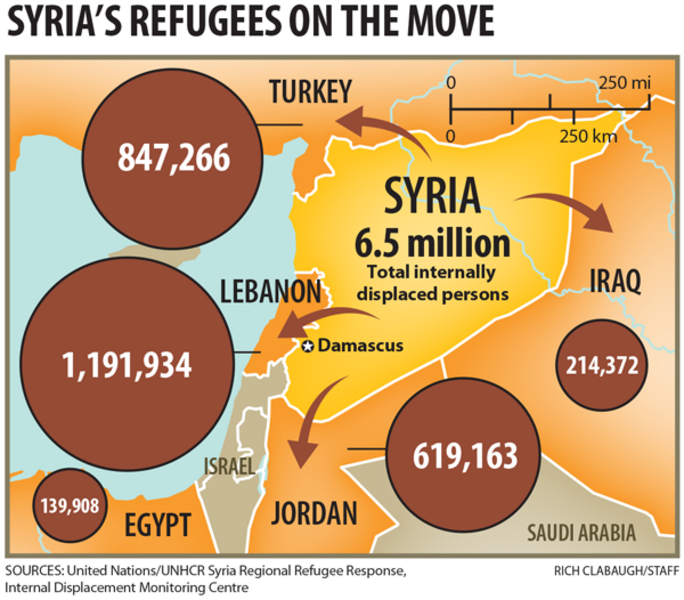Refugee numbers rising: four questions about those from Syria and beyond
Loading...
Wars in Syria and northern Iraq are launching new waves of refugees, and the burden they place on host nations is growing. While relief agencies have gotten better at providing basic aid, longer-term assistance may be required. Here are four questions about refugee situations.
What’s behind the rise in refugees and internally displaced persons?
Since 2011, the civil war in Syria has been the biggest driver of displaced populations, the largest since the Rwandan genocide in the mid-1990s. More than 9 million Syrians – well over one-third of the country’s 23 million people – are either internally displaced or have fled across borders to Jordan, Turkey, Lebanon, Egypt, and elsewhere.
The conflicts in Afghanistan, Somalia, Sudan, and Congo are more long-term contributors to the total, but renewed strife in Iraq and sectarian tensions in Nigeria are causing displacements on a scale that is taking even experts in the field by surprise.
Which countries are bearing most of the burden of the burgeoning refugee population?
Pakistan and Iran have long held the top two spots on the list of countries hosting refugee populations, in both cases as a result of neighboring Afghanistan’s decades of war. But many of those Afghans have by now settled in.
Today Syria’s neighbors are bearing the brunt of the recent steep rise in refugees. Lebanon, already a country torn by sectarian divides, has been pushed to the brink of its own conflict with the arrival of more than 1 million Syrian refugees.
Jordan, a country of 6.5 million people, is now hosting about 1.4 million mostly Syrian and Iraqi refugees (only about half of whom are officially registered with the United Nations High Commissioner for Refugees, the world’s chief refugee care organization) or about 20 percent of the population.
To help Americans understand the effect of that influx on the country’s social fabric, Jordan’s King Abdullah points out that the United States would have to take in 60 million refugees to reach the same proportion of the population.
Turkey has also received more than 1 million Syrian refugees, though it has a much larger population by proportion and a stronger economy than Jordan has. But a surge of ethnic-cleansing operations by Islamic State militants across northern Syria has sent tens of thousands of Kurdish and other refugees into Turkey in recent weeks – multiplying a burden that would be a challenge for any country.
Nigeria’s neighbors are also seeing an influx of refugees fleeing Boko Haram and other perpetrators of ethnic and sectarian strife.
Where do children figure in the global surge of displacement, and what effect is it having on them?
Many people may think first of young men fleeing war and seeking better economic opportunities when they hear “refugee.” But in reality about half of the total refugee population are children under age 18 – a slice of the total that has been increasing in recent years.
Most of the youngest children are part of refugee families, but a growing number of children as young as 7 are fleeing conflict on their own or in groups of children, such as the large numbers of Central American children that crossed the US southern border earlier this year, many claiming to be fleeing violence at home.
Children fleeing conflict on their own are at greater risk of exploitation, experts say. They become easy prey for human traffickers looking to feed a global sex trade or, in the case of boys, a demand for fighters.
But even child refugees who remain with their families run a high risk of seeing childhood cut short: Education is often replaced by menial labor.
The Syrian refugee camps of Jordan are experiencing an epidemic of child brides, experts say, with girls as young as 12 being married off – both as a means of easing a family’s dire financial straits and in the hope of providing daughters with a male protector.
What are the prospects for serving the refugees and displaced populations – or of reversing their rising numbers?
The UN High Commissioner for Refugees and the countries and nongovernmental organizations working with refugees have gotten better over the past decade at delivering services, including sanitation and education, to refugee populations, many experts say. The US has provided $2.4 billion in humanitarian assistance to Syrians inside and outside Syria since the war began more than three years ago.
But with no end in sight to the Syrian war, with conflicts in Central Africa grinding on, and with new spikes in sectarian violence and religious extremism across the Middle East and North Africa, prospects for slowing the rising tide or of returning large numbers of refugees home appear dim.
Given that scenario, some experts say the focus of refugee assistance will have to shift increasingly from relief to longer-term objectives such as education, access to employment, and broadening the economic opportunities of refugees.








